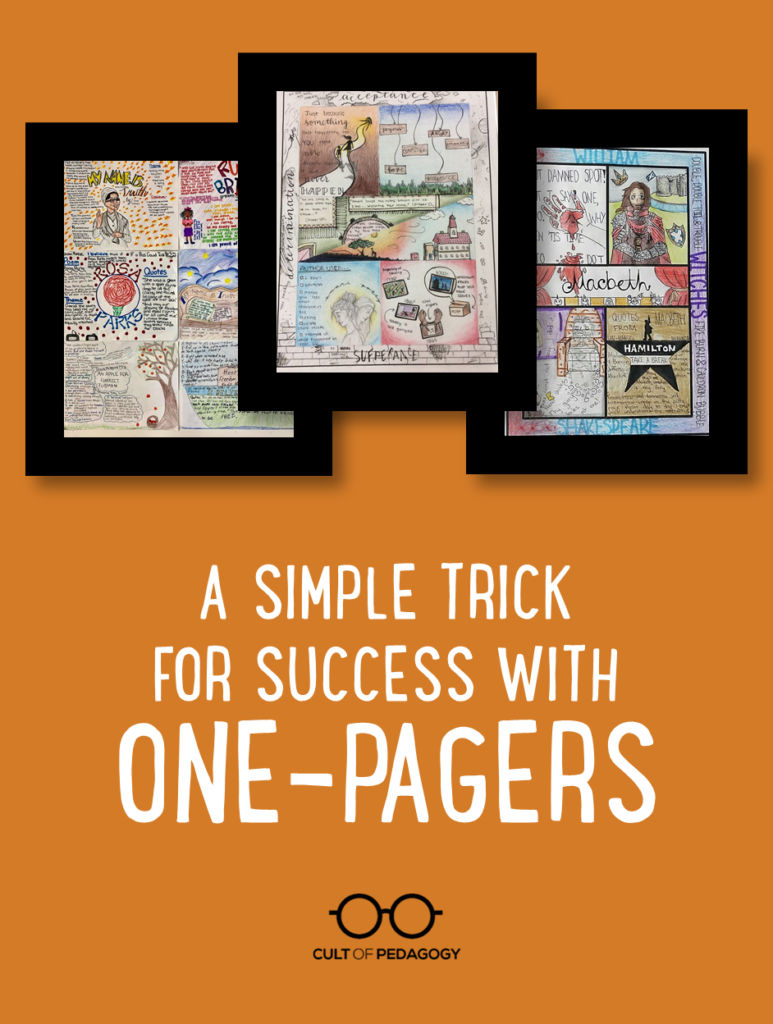
Listen to my interview with Betsy Potash (transcript):
Sponsored by Chill Expeditions and Kiddom
Have you heard the whispers about one-pagers in the online teacher hallways? The concept of a one-pager, in which students share their most important takeaways on a single piece of blank paper, has really taken off recently.
The one-pagers I see on Instagram draw me in like a slice of double chocolate mousse cake. The artistry students bring to representing their texts on a single piece of paper, blending images and ideas in creative color, is almost hypnotizing for me. Perhaps you’ve had the same experience.

But it’s the very beauty of the models that get posted that can drive students and teachers away from the one-pager activity. Sure, it’s great for super artistic students, we tend to think, but what about everyone else?
Turns out it CAN be great for everyone. As long as you know how to structure it.
What Is a One-Pager?
Let’s backtrack a bit and talk more about what a one-pager is. It’s pretty simple, really. Students take what they’ve learned—from a history textbook, a novel, a poem, a podcast, a Ted Talk, a guest speaker, a film—and put the highlights onto a single piece of paper. AVID first developed this strategy, but now it’s widely used in and out of AVID classrooms.
But why is this seemingly simple assignment so powerful?
As students create one-pagers, the information they put down becomes more memorable to them as they mix images and information. According to Allan Paivio’s dual coding theory, the brain has two ways of processing: the visual and the verbal. The combination of the two leads to the most powerful results. Students will remember more when they’ve mixed language and imagery.
Plus, one-pagers provide variety, a way for them to share what they’ve learned that goes beyond the usual written options. Students tend to surprise themselves with what they come up with, and their work makes for powerful displays of learning. Plus, they’re fun to make. Let’s not pretend that doesn’t matter.
So, assuming you’re sold on trying this out, you’re probably wondering what exactly goes into a one-pager?
Students might include quotations, ideas, images, analysis, key names and dates, and more. They might use their one-pagers to make connections to their own lives, to art or films, to pop culture, to what they’re learning in their other classes. They might even do it all. You’d be amazed at how much can fit on a single piece of paper.
Many teachers create lists of what students should put inside their one-pagers. Knowing they need two quotations, several symbolic images, one key theme, etc., helps guide students in their work.
The Art Problem
When creating one-pagers, artistic students tend to feature more sketches, doodles, icons and lettering. Students wary of art tend to feature more text, and can be reluctant to engage with the visual part of the assignment at all.
It was this issue—the issue of the art-haters—that first drew me into one-pagers two years ago. I had seen some stunning one-pagers posted in my Facebook group, Creative High School English. But the comments that followed were always the same. “That’s amazing work! But so many of my students don’t like art….”
Those comments struck a chord with me. For years I had dealt with comments from some of my own students about their distaste for artistic materials when I would introduce creative projects. No matter how much I explained that it was the intention behind their choices that mattered, I always got some pushback if there were any artistic elements involved in a project.
Was there a way to tweak the one-pager assignment so every student would feel confident in their success?
Another problem was one of overall design: Though they knew they needed to hit all the requirements their teachers listed, students still seemed to be overwhelmed by that huge blank page. What should go where? Did colored pencils really have to be involved?
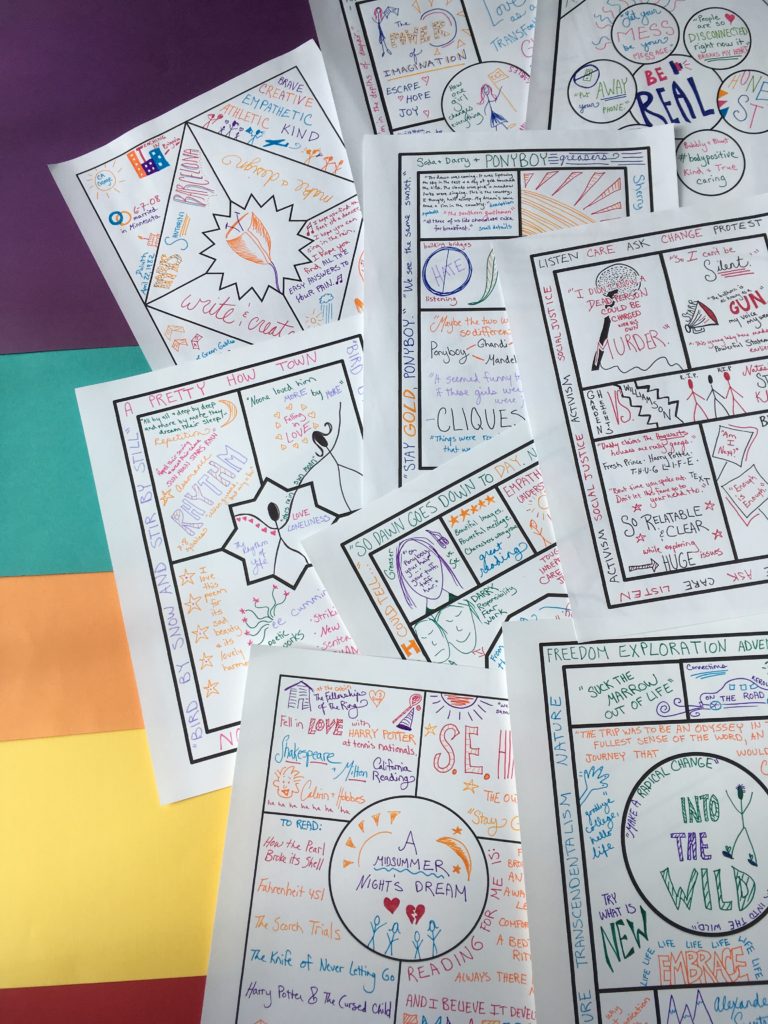
A Simple Solution: Templates
As I thought about the problem, I wondered if students would feel less overwhelmed if they knew what needed to go where. If the quotations had to be in the middle, the themes in the upper left, the images across the bottom, etc. I began to play around with the shapes tool in PowerPoint, creating different one-pager templates.
Then I began shaping my requirements, correlating each element with a space on the paper. Maybe the border could be the key quotations. The center would feature an important symbol. The themes could go in circles around the center. I developed a bunch of different templates for varied ways to respond to novels. Then I tried podcasts. Films. Poetry.
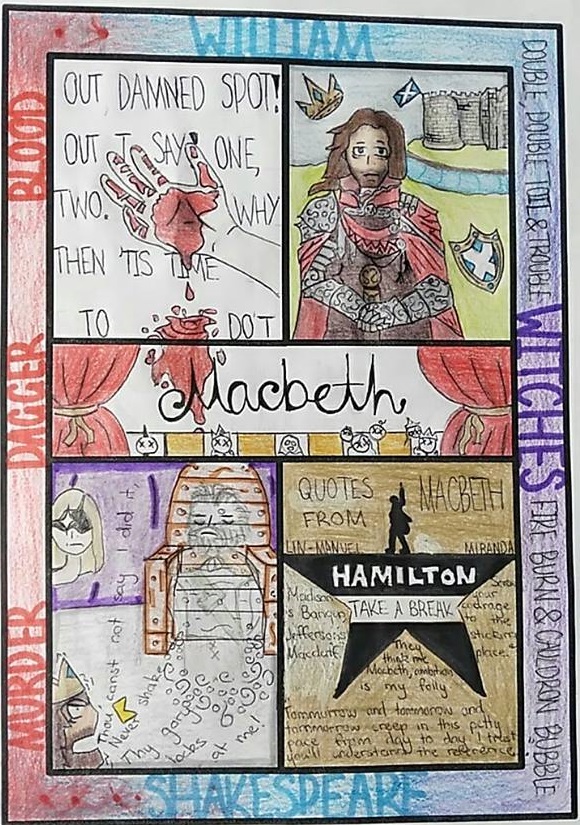
One-pager by the Student of Heather Bainbridge, Collège Jacques Monod, Les Pennes Mirabeau, France
(This template is available free here.)
As I shared these templates with other teachers, I kept getting the same feedback: “It’s working!”
That little bit of creative constraint actually frees students to use their imagination to represent what they have learned on the page without fear. They know what they need to put down, and where, but they are also free to expand and add to the template. To choose their own colors. To bring out what is most important to them through their creativity and artistry. And those super artistic students? They can just flip the template over and use the blank page on the back.
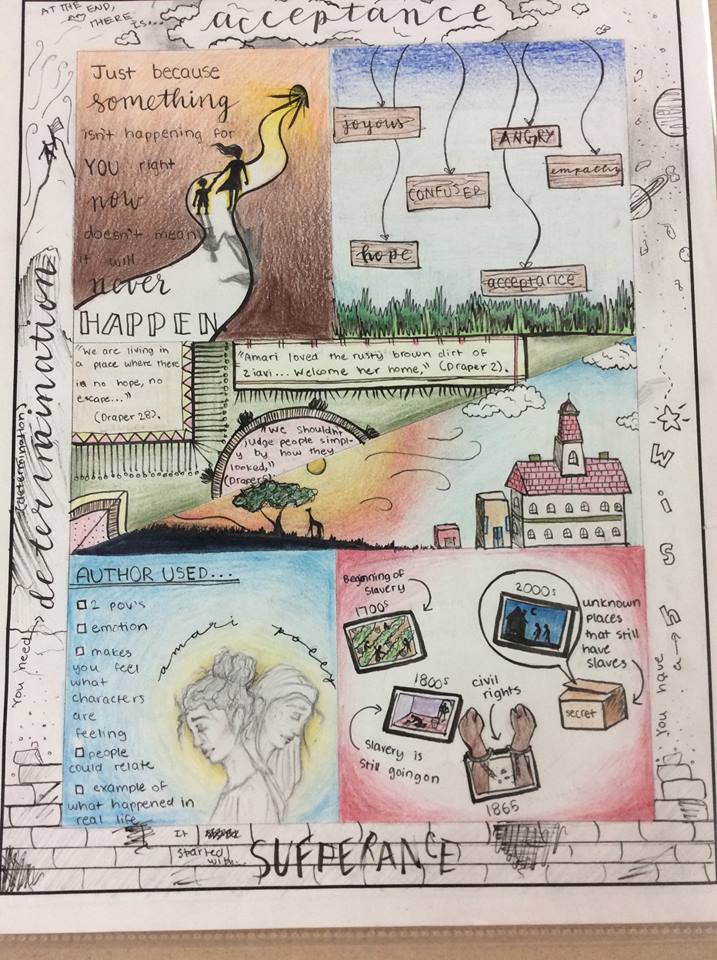
(This template is available free here.)
Beyond Novels
There are so many ways to integrate this creative strategy into your classroom. While one-pagers lend themselves beautifully to final assessments after reading independent novels, literature circle selections, or whole class novels, that’s really just the beginning.
You can use them to get to know students better, as with a name tent or “about me” one-pager at the beginning of the year. One school used templates to have every student create a one-pager about their own lives, collecting them all into hallway displays as part of a project they called “Tell your Story.”
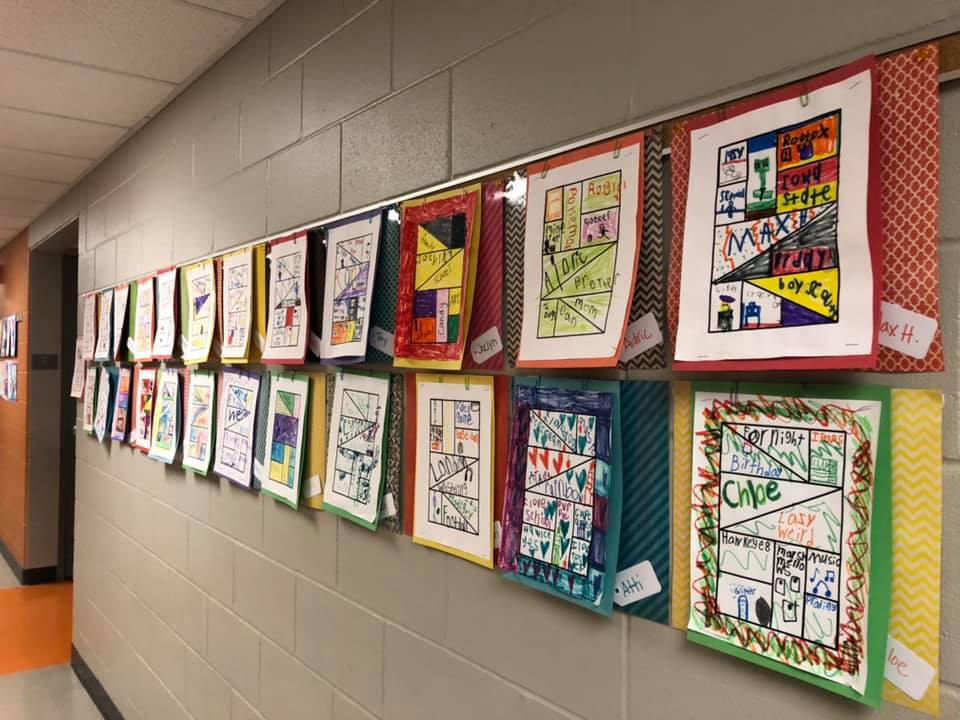
You can also use them to help students focus in on the most important information in nonfiction articles and books. One EFL teacher in Croatia used the templates to have students share key takeaways from articles they read about social media. Not only did students have to analyze the text deeply to figure out what was most important, but the dual-coding theory suggests the process of creating the one-pagers will help them remember the information better.
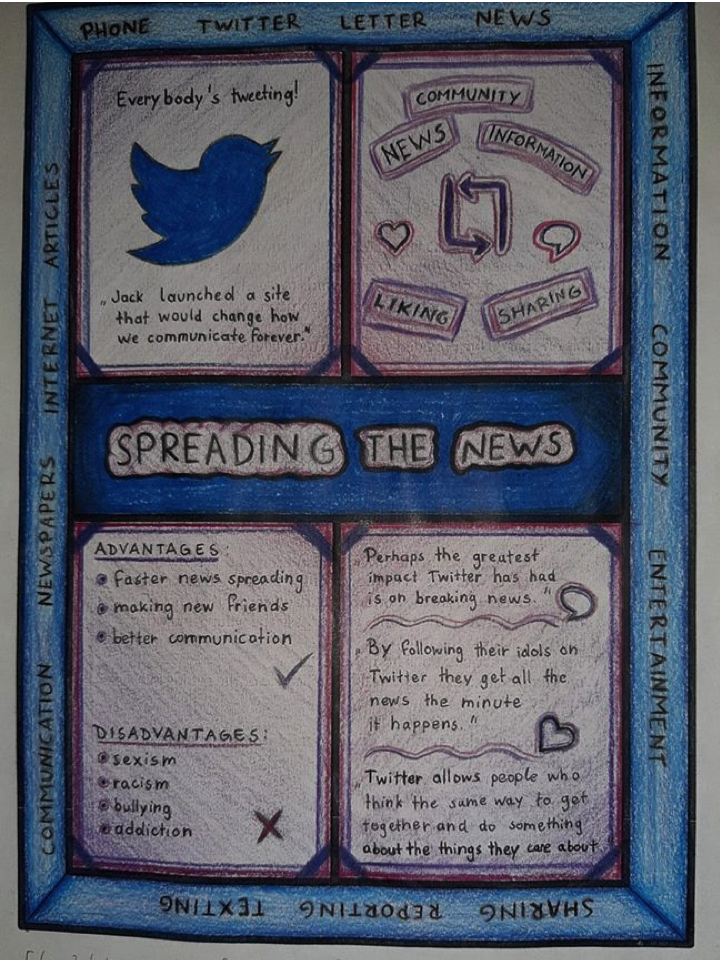
(This template is available free here.)
Another great use for one-pagers is to keep students focused while absorbing media. When students are watching a film, listening to a podcast, or even attending an assembly with a guest speaker, they can be creating one-pagers as they listen, a kind of formalized version of sketchnotes.

Simple Steps for One-Pager Success
Whenever you’re considering your options for assessment, throw one-pagers into the mix. The steps below should help you in creating an assignment for which every student has a roadmap to success.
1. Choose the elements you want your students to put onto their one-pagers. For example, quotations, key themes, literary elements, discussion of style, important characters or dates, connections to other disciplines, connections to their lives, connections to modern culture.
2. Create a layout using the shapes tool in PowerPoint or something similar (or grab a free set of templates here or here).
3. Connect your instructions to your layout. Make it clear which elements should go in which area of your template.
4. Create a simple rubric with the key categories you want your students to succeed with. With literary one-pagers, I use “Textual Analysis,” “Required Elements,” and “Thoroughness.”
5. As you introduce the assignment, show students some examples of one-pagers to give them a sense for how they might proceed.
6. Give students time to work on their one-pagers in class so they can ask you questions. Consider providing some artistic materials if you can, or inviting students to bring them in. You can always let them complete the work at home if necessary.
7. Do a gallery walk of the one-pagers before you collect them, or have them present to each other in small groups. The students will learn a lot from seeing each other’s representations.
8. Create a display after you grade the one-pagers with your rubric.
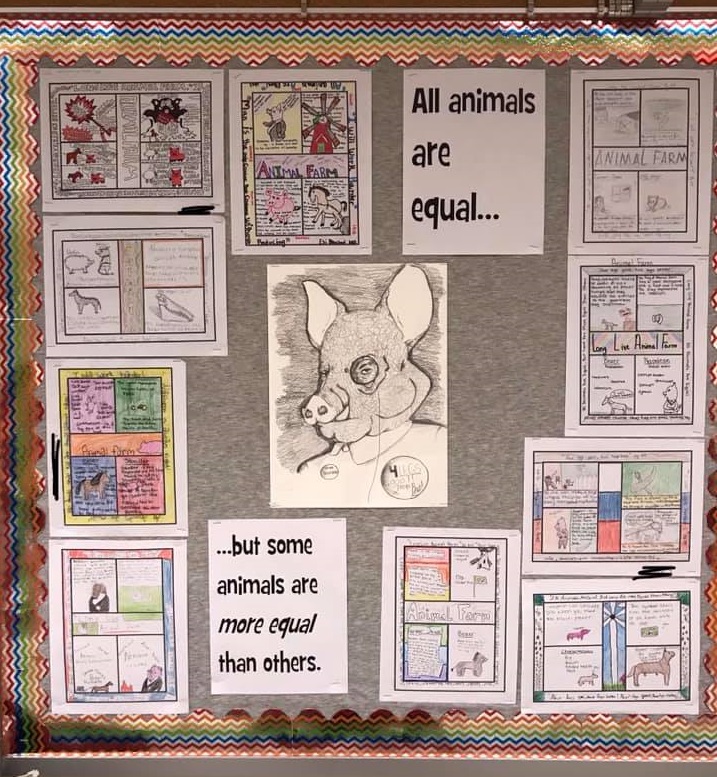
(This template is available free here.)
You can find more of Betsy’s great ideas on her website, Spark Creativity.
Join our mailing list and get weekly tips, tools, and inspiration that will make your teaching more effective and fun. You’ll get access to our members-only library of free downloads, including 20 Ways to Cut Your Grading Time in Half, the e-booklet that has helped thousands of teachers save time on grading. Over 50,000 teachers have already joined—come on in.


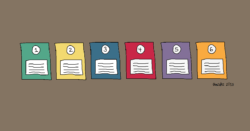
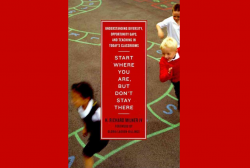

Using this for assessment is also a great idea to provide an idea of student learning. Can you comment on how you use these for assessment and how you assess the one-pagers? Thanks!
Hi Kim,
I think one-pagers make a great closing assessment for many units. They provide a chance for kids to really sum up everything they’ve learned, whether it’s from a novel, a series of poems, a part of history, etc. I think it helps a lot to grade them from a clear rubric – if you download my free set of templates, it includes the rubric I designed. You might want to grab it, just to help you design your own if you prefer.
Hope this helps!
Betsy
i think the students really help between to encourage other students to be creative and loyal to others and make up your own ideas.
Can you share a link to your rubric templates?
Hi Tish, you can go to A Simple Trick for Success with One-Pagers and find the links to the rubrics. If you look at the captions under the images, there’s a link to download them directly. Hope this helps!
I assess one-pagers against our education department’s rubric for written work – we have one for personal response (ideas + presentation) and another, more elaborate one for essays (content + support + form/structure + choices + correctness). It transfers nicely to one-pagers, and provides enough buffer for the kids who fear the artistic components. Here are our rubrics: https://www.alberta.ca/assets/documents/edc-2019-2020-ela30-1-scoring-guide.pdf
Hi there! This is awesome! Do you have any samples or formats for a math class? Algebra 1 and Geometry? I can see this more so with geometry since there’s lots of shapes and visuals. Thanks for your help and input!
I had students make a math one (I teach 6th grade) as a 2nd semester review. They had to include 3 things from each unit from that semester. Since we had 5 units, they broke the paper up into 5 sections.
Hi Brittany,
That sounds like a wonderful review! Did you encourage them to bring in some visuals and color to help bring the concepts to life? I hope it went well!
Betsy
Hi Janice,
I’m afraid I don’t have any examples for math, but I think it would work very similarly. I would suggest template sections on main ideas from the unit, illustrations of the main ideas, connections to students’ own lives and the modern world, connections to other math concepts, etc. I hope that’s helpful!
Betsy
I love this idea! I’m wondering how to tweak it to use in our math classrooms. Time to start experimenting. Thank you for this!
This is so helpful. I am a math teacher and a mother. My teenage son would come to a screeching halt whenever he had to generate a visual representation, because he dd not know how. I finally convinced him that, since the teacher had not *taught* him any art, and would not be *assessing* him on the artistic merit of his work, that, for instance, tracing was an ok thing to do. We expect kids to “do art” when they have not been taught how to, and some of them are not in a position (for whatever reason) to spontaneously “do art.” Why is this? (BTW, I hold a BFA.)
Hi Johanna,
I hear you! It’s sad for me how little artistic outlet our students get these days, if they don’t choose to follow it on their own. It’s one reason I love this type of assignment, that can let those who flourish with art fly, and provide some reasonable small steps for those who feel intimidated by it. I’m glad you found these ideas helpful!
Betsy
I’ve been hearing about these for a while! So glad to see this break down of the activity. I think creating templates is such a wonderful idea to help those students who struggle to see themselves as creative. I had my writing students create infographics this past semester, and showing them all the templates on canva really helped them feel more comfortable with creating their own examples of the genre. I’m definitely going to give this activity a try, potentially as a shareable attachment to their short autobiographies at the beginning of the semester. Thanks for the idea!
Erika, I’m so glad you find the template idea helpful! I couldn’t agree with you more about how helpful it is to share some structure ideas when approaching a design task – I love Canva too. I’ve seen some great results with one-pagers reflecting kids’ own lives, so I hope the autobiographical one-pagers will turn out well for you!
Another way to get around the “art” issue, is to use digital templates online such as the pre-set templates available on platforms like Pictochart, or create your own to share and use within Google Classroom. Encourage students to use free graphics from Copyright Commons approved sites, create comic strips to import from tools such as Pixton, etc. Another way to increase student engagement and engage in multimodal meaning making…
What great ideas! I love giving kids the option to go digital if they feel comfortable in that design space, and these are a lot of wonderful specific options. Thanks!
I teach high school physics. I can think of ways for astronomy and earth science but what of Newton’s laws or projectile motion. A section for equations. A definition perhaps. What else? Any suggestions?
What about sections that illustrate some of the principals, and a section that shows examples of practical applications of the scientific laws in students’ own lives?
I’m a science teacher, too. I know someone who assigned “Newtoons”, where kids had to think of a real world example and apply Newton’s laws to it in the form of a cartoon. Perhaps that could be incorporated into a one pager?
I think I will check out Newtoons
I would love some advice on how to use this with college math students.
Hi Lauren,
I think it can be adapted to math with pretty similar template sections. You could have sections for main concepts, key equations, connections to other math or science concepts, connections to the real world, etc. And throughout, you could encourage students to create visuals that demonstrate the information to go with their text.
I hope that’s helpful!
Betsy
I went digital with one pagers this spring. Students used Adobe Spark to create and published on a class Padlet. Voila! No art supplies needed (and by May, few are to be had!).
Digital is a great option for one-pagers! Canva would be another fun place to experiment for those without access to Spark.
One other alternative is to pair up two students for the one-pager. One student could be more artistic/visual and the other more textual. Such a pair would have to learn to cooperate, communicate, and build on each other’s strengths. The process could be just as important as the product. Alternatively, each person in the pair could separately come up with various parts of the design. They would then meet to choose which elements to include or re-design to make the one-pager.
Tim,
This is a great idea! Thanks for sharing.
Hi,
I love having students gallery Walk their one pagers, but not sure what sort of accountability piece to have students complete as they do the gallery Walk and examine each other’s works. Any suggestions would be great!
Hi Courtney,
I may have some suggestions for you for this. When my students do gallery walks, they usually complete a graphic organizer that sits with the work of each author. There are two forms I like to use: the Glows and Grows and the TAG sheet. The format is up to you but it can be as simple as a 2- or 3-column table on a page. The Glows and Grows is just two categories: One glow telling what the author did well, and one grow telling what they can do to make their work even better. The TAG sheet is similar but takes it one step further. T- Tell something you liked, A- Ask a question, G- Give a suggestion. I find that both these tools help students recognize good practices in their work of their peers, help them to spot errors that they might want to avoid, and give solid feedback that they respect because it’s coming from their peers. Hope you find this helpful!
What a cool way to let each student play to their own strengths. Thanks for sharing!
Thanks for this simple break down. I do a lot of writing and I’d like my students to be more reflective of what they learn from each assignment, particularly when we address a new style of writing. Any suggestions on how to use this with writing?
Hi Lauren,
There are a few solid ways to use one-pagers around writing. One is to use it as an argument writing activity, or pre-writing. You can create a template where there are places for main ideas, counterarguments, quotations, and a thesis, all to be shared through both text and imagery. Another option would be to get meta and create a one-pager that is actually about the type of writing the student has just tried out and reflects the work they did and what they need to improve. With this type of template, you could create space for the main structures of the writing, what the student excelled at, and what they need to work on for the next iteration. Again, all to be shared through both text and imagery. Yet one more option would be to create a series of mini-one-pagers throughout the year that reflect writing type. So you could teach them the structures of different types of writing and have them create small illustrated versions to put together as a guide for themselves moving forwards. At the end of the year, they’d have a little book illustrating argument writing, opinion writing, compare and contrast, etc.
Hope those ideas help!
Betsy
I love one pagers and have used them for the last few years both with and without the template. I also taught my students how to make an infographic this year using Canva and they loved it. I think next year, I will combine the two and have them make their one-pager electronically so that both the artistic kids and the non-art lovers can be equally successful.
I have been doing projects similar to these for many years:))) Love the way you broke the ideas into steps and defined the process. Templates are great!!!!
I provide the option of collaging from magazines for my students who see themselves as less artistically inclined. They can do just collage or combine collage elements with some of their own drawings. I find this makes them feel less insecure about their drawing abilities. An unintended bonus is that some students have realized that they can be artistic without having to put pencil or paint to paper.
Love this idea of a collage for an option! I am trying one pagers this year in history to review units prior to quizzes and tests.
Love these. I have often used the Frayer model – with adaptions- for math and science concepts and or just terminology.
I used One-Pagers with my AP Human students as an end of year review. Students had to do one One-Pager per chapter. My students told me this was the best review and the most enjoyable work they did all year. They really felt this prepared them for the AP exam. Even the non-artistic students did a beautiful job!
I am using this as a project for a movie we’re watching. I’m allowing them to utilize the template or free-style, as I have quite the range of skill and anxiety in my class. Thank you for sharing.
Vickie,
We are glad to hear that you’re planning to use one-pagers in your class. Let us know how it goes with your students.
Betsy,
How do you encourage students to use images? In providing a checklist of items I wanted students to include, somehow the One-Pagers my students recently completed for social studies included mostly text. Do I also require a certain number of images? amount of color? When I used One-Pagers last year, they were much more successful. I don’t recall how my prompt was different. I use your marvelous templates (thank you) and examples (thank you again) and the directions that identifying specific information needs to be considered. What is missing? Why aren’t the images a focus? How might I change my prompt.
With appreciation,
Lisa
Hello!
What is the research behind one-pagers? I would like to incorporate this method into my classroom.
This is wonderful, and it’s exactly what my students need! I’ve wanted to incorporate one-pagers into our units, but my anti-art, special ed students have balked at the idea. Thanks for sharing these templates!
Stacy,
We are glad that this is exactly what you needed for your students!
I agree with all of you
I love this concept of a one pager to summarize a lesson. I teach kindergarten and can see how the students can use this technique to introduce themselves to the class.
I have never heard of the concept of using one-pagers in a classroom, though I can vaguely remember doing something very similar in a high school English class. After reading this blog post and listening to the interview, I am very excited to work this into a lesson plan that I am currently working on! Thank you for the tips and information on how to do these correctly.
I’ve tried to incorporate one pagers in my high school history classes but have struggled with how to use them effectively. The students were often intimidated or overwhelmed and the lessons seemed to flop every time. Thank you for the walk through of your process and templates. My attempts were missing the structure/parameters my students needed to be successful. I’m excited to tweak my lessons for next year and use the strategies you discussed.
Does anyone know of research related to using digital tools to write and draw and does this help or hinder learning?
Hello there. I am 14 years old. i need some help unfortunately with completing a one pager for school online. Do you know where I could go?
– Bella
Hey Isabella,
We’re sorry to hear you’re having trouble with this. Our advise is to reach out to your teacher or classmates – they should be able to help you. Good luck!
HI! Just wanted to give you a heads up that the AVID link at the beginning of the post is not working–it routed me to website that looked like a professional soccer club. I am not sure which one because the website is in Chinese, or Korean, or Japanese, or some other language I don’t know well enough to recognize! Thanks!
Hey Kelly,
Thanks so much for the heads up! The link has been updated.
hey kelly , thanks so much for the heads up and thanks for everything.# love it give you the deets.
This will be my first use of a one-pager. Your information will be most valuable as I present it to the students..
This is an amazing idea! As I was reading my brain was coming up with all kinds of way I could adapt this further for Special Education when some students needs a different way to express what they’ve learned throughout a unit. I feel like so many people shy away from artistic projects so that they don’t pressure those “less artistic” students when they should be supporting their creative processes by making these projects more accessible. Wonderful read.
Hi Lauren,
There are a few solid ways to use one-pagers around writing. One is to use it as an argument writing activity, or pre-writing. You can create a template where there are places for main ideas, counterarguments, quotations, and a thesis, all to be shared through both text and imagery. Another option would be to get meta and create a one-pager that is actually about the type of writing the student has just tried out and reflects the work they did and what they need to improve. With this type of template, you could create space for the main structures of the writing, what the student excelled at, and what they need to work on for the next iteration. Again, all to be shared through both text and imagery. Yet one more option would be to create a series of mini-one-pagers throughout the year that reflect writing type. So you could teach them the structures of different types of writing and have them create small illustrated versions to put together as a guide for themselves moving forwards. At the end of the year, they’d have a little book illustrating argument writing, opinion writing, compare and contrast, etc.
Hope those ideas help!
Betsy
woah that is soooooo cool!!!
I think one-pagers are amazing. It’s a great way to express everything and show beautiful drawings and art! All of these photos are fantastic and creative. I don’t know why, but this is my favorite way of writing and I absolutely love drawing, so this is a great way to write for me 🙂 these people skills are just.. awesome! It’s also one of the easiest ways to write. Such a great idea.
Hey the AVID link is sending me to a 404 page, also love the content of these, I am a student and I believe this helps me a lot. KEEP IT UP!
Chris, thanks for bringing this to our attention! Our team will look into it. I’m so glad the posts have been helpful for you as a student!